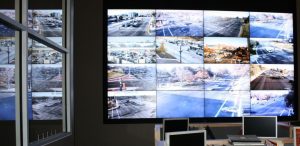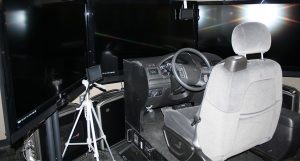 The Traffic Lab is a unique applied research facility at the University of Utah. It is supervised by faculty and staffed by graduate students, mostly from the Department of Civil and Environmental Engineering. The heart of the lab is a Traffic Operations Center. With equipment, software, hardware, and communications infrastructure costing nearly three quarters of a million dollars, the lab is connected to Utah State and city traffic control centers. In an emergency, it can serve as a temporary communications center. Its role is to serve local, regional, and international constituencies in developing new approaches to the control, monitoring, and management of road traffic. The lab has a long standing relationship with the Utah Department of Transportation, which has commissioned over 40 studies.
The Traffic Lab is a unique applied research facility at the University of Utah. It is supervised by faculty and staffed by graduate students, mostly from the Department of Civil and Environmental Engineering. The heart of the lab is a Traffic Operations Center. With equipment, software, hardware, and communications infrastructure costing nearly three quarters of a million dollars, the lab is connected to Utah State and city traffic control centers. In an emergency, it can serve as a temporary communications center. Its role is to serve local, regional, and international constituencies in developing new approaches to the control, monitoring, and management of road traffic. The lab has a long standing relationship with the Utah Department of Transportation, which has commissioned over 40 studies.
The lab also receives support from the US Department of Transportation through a continuing series of five-year programs. The Mountain Plains Consortium(MPC) is a regional transportation center, funded through the USDOT Universities Transportation Centers program. The Traffic Lab is a member of MPC. A federal grant supports research and technology transfer. Faculty members communicate with practicing engineers through a well equipped and dedicated video conference facility. The lab’s students have the opportunity to present their work to Departments of Transportation engineers from 12 western states. The video conference network draws universities from the West Coast to the Plains states into direct contact with State Departments of Transportation.
The traffic lab has been busy since its initial research project in 1995. At the time, Governor Michael O. Leavitt was seeking
innovative ways to finance a new highway in Davis County. The lab study showed how a demand sensitive high-tech toll system could fund up to a half of the cost of the Legacy Highway. The idea of a toll road was dropped because it was considered too contentious. Perhaps Utah drivers weren’t ready for a demand sensitive toll system which has proven successful in other urban centers. History has shown that there was enough controversy inherent in the project.
Since that first study, the Utah Traffic Lab has expanded by addressing both local and international research interests. Locally, the lab has studied many questions that affect traffic efficiency: How do advanced traffic responsive signal systems really perform? Should we re-build our highways under the traditional form or pay for 'design-build'?
Always ready to tackle local research needs, the lab also sustains a core research effort that reaches an international audience, with a primary focus on advanced traffic signal systems. Traffic lights are one of the first and still most pervasive traffic control systems worldwide. Ongoing research at the University of Utah is helping to advance the state of the art technology and systems design to improve safety and ease congestion.
The lab was led by Dr. Peter Martin from its first day until his departure from the university in 2012. Currently, research activities at the lab are supervised by Dr. Cathy Liu and Dr. Juan Medina
